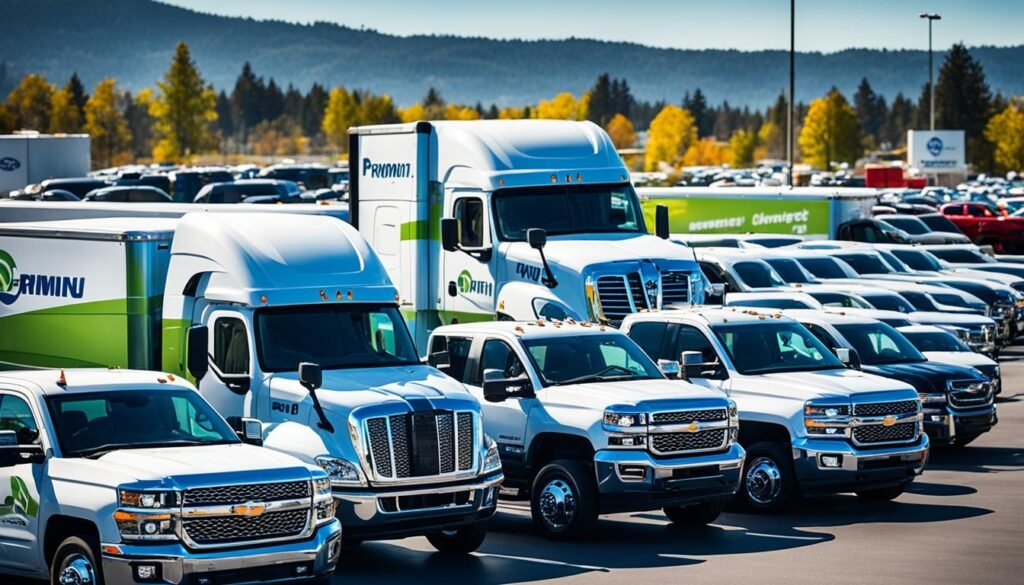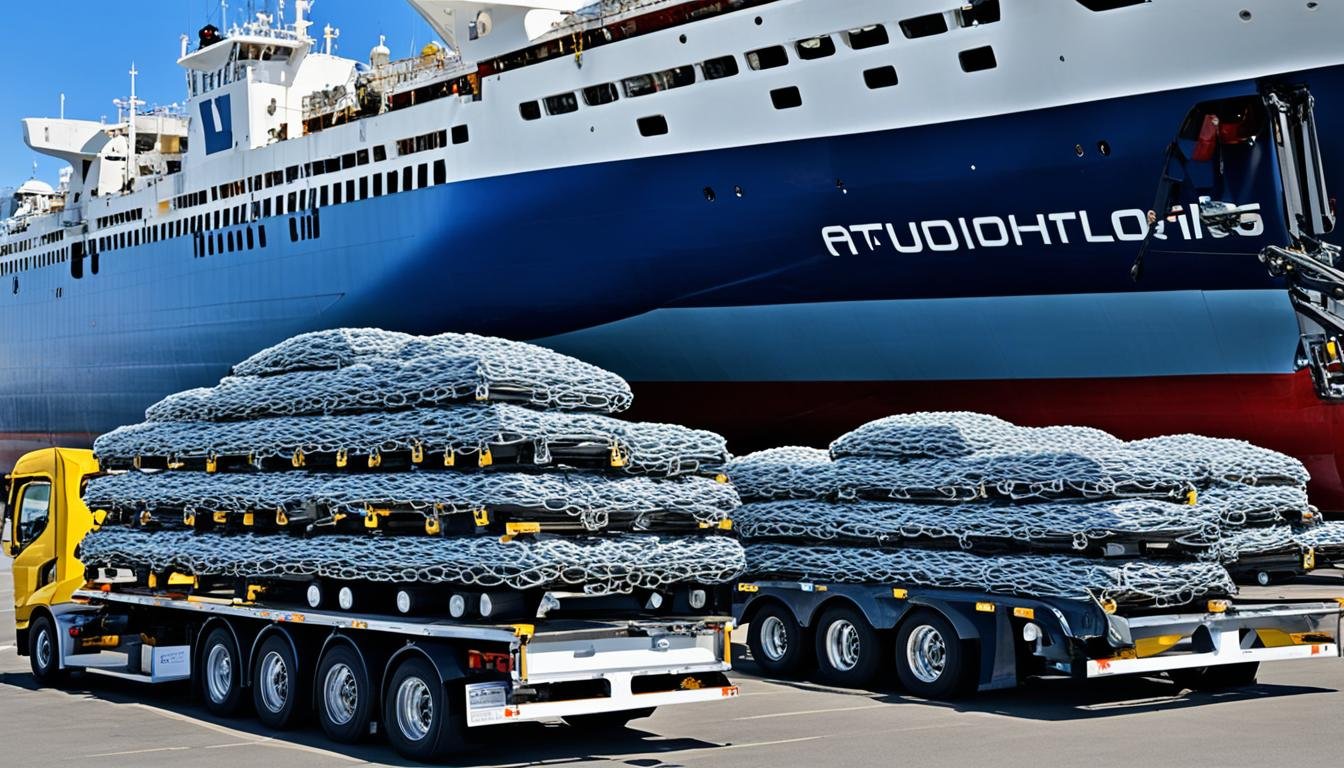Shipping cars for dealerships must be done with care. It’s vital to keep the cars safe. This keeps the dealers’ reputation high and customers happy. Let’s look at how dealerships can make sure their cars stay safe during shipping.
Key Takeaways:
- Auto transport safety is essential for dealerships to protect their valuable inventory during transit.
- Dealerships have the choice between open car transport and enclosed auto transport for shipping their vehicles.
- Proper immobilization of vehicles using wheel straps and tie-down ratchets is crucial for ensuring their safety during transport.
- Different vehicles may require specific securements based on their size, condition, or special features.
- Removing exterior and interior accessories, as well as personal belongings, enhances auto transport safety.
Choice of Car Shipping Service
Choosing the right car shipping service is key for dealerships. They can pick between open car transport and enclosed auto transport. It is important to consider the benefits and downsides of each.
Open Car Transport
Open car transport is the most common shipping method. With this choice, vehicles travel on open trailers. They are not protected from weather or road debris. Despite this, open car transport has many advantages.
- Open car transport is the most budget-friendly option for dealerships.
- Since it’s common, scheduling is usually easier, with more available carriers.
- It often leads to quicker delivery times due to a wider carrier network.
Enclosed Auto Transport
Enclosed auto transport is best for valuable or special cars. It uses closed trailers for protection. The vehicles are sheltered from weather and other dangers. But, there are a few things to think about.
- It provides the most secure protection.
- Enclosed transport is ideal for luxury or vintage vehicles.
- It might take longer because of limited trailer space.
- However, this safety comes at a higher price.
The decision boils down to what the dealership needs. It’s about the car’s worth, safety, budget, and when it needs to arrive. Deciding what matters most will point to the best shipping choice.
Check out the table below for a quick comparison of open car transport and enclosed auto transport:
| Open Car Transport | Enclosed Auto Transport |
|---|---|
| Cost-effective | Maximum security |
| Flexible scheduling | Suitable for valuable/specialty vehicles |
| Faster delivery | Reduced capacity |
Immobilizing the Vehicles
Keeping cars secure during transport is very important. It stops them from moving in different ways on the road. Using wheel straps and ratchets helps hold the cars down safely.
Four tiedowns are needed to keep a vehicle still. Two are put in the front and two in the back. They hold onto the car’s frame and wheels. This stops any chance of it moving by mistake while being shipped.
Wheel straps go around the tires to keep them stable. Ratchets help make sure everything is tight. This setup makes sure cars stay in place on the trailer.
Securely holding cars in place is about more than just keeping the cars safe. It’s also about keeping everyone else on the road safe. This setup keeps the cars from moving, making the roads safer for all.
Benefits of Secure Car Immobilization:
- Prevents damage to the vehicles during transit
- Makes the road safer for other vehicles
- Lessens the chance of accidents and injuries
- Gives peace of mind to dealers transporting valuable cars
Special Securements for Different Vehicles
When shipping vehicles, they need specific securements for safety. Classic cars, salvage vehicles, and oversized vehicles have special needs. These needs involve distinct securement methods for their safety while on the move.
Classic cars, known for their beauty, call for extra care in transport. Extra strapping around the tires helps protect them. This extra support and stability lower the risk of any harm. Transport experts use these methods to keep classic cars in perfect shape during shipping.
Salvage vehicles have possible prior damage, which makes them fragile. Special securements are used to give them added support. This includes keeping the vehicles’ bodies and wheels tightly in place. It helps avoid extra harm as they’re moved.
Oversized vehicles like big trucks or SUVs need special attention too. Due to their size, they need heavier straps and larger ratchets. Professionals in auto transport know how to apply these properly. They ensure that such large vehicles are safely kept in place for their journey.
All vehicles are treated with the upmost care by transport companies. They consider each vehicle’s specific needs carefully. By focusing on what each car needs, they ensure safe and reliable transport. This is true for all vehicles, regardless of their size, state, or uniqueness.
Example: Vehicle-Specific Securement Requirements
| Vehicle Type | Securement Method |
|---|---|
| Classic Cars | Extra strapping around tires |
| Salvage Vehicles | Specialized securements for weakened structures |
| Oversized Vehicles | Stronger and wider straps, larger ratchets |
Exterior and Interior Accessories
Making your vehicle safe for transport is key. Taking off things like roof racks and bike racks helps. It stops them from falling off or causing issues. This keeps them safe and prevents trouble for your car or others nearby. So, by taking off these items, you can feel sure your vehicle will travel safely.
Keeping the inside safe is just as crucial. Hold on to things like seat covers and cell phone holders. This keeps them from sliding around and hurting your car’s inside. A safe interior means your car will look as good as new when it arrives. It makes the whole shipping process worry-free.
It’s also smart to take out your personal stuff before shipping. This lowers the chance of losing or having things stolen. It keeps your valuables safe and away from the shipping process. Doing all this boosts your car’s safety while it’s on the road.
In the next part, we’ll see why checking your car well before it ships is vital. This makes sure everything goes smoothly from start to finish.

Importance of Inspection at Pick-Up and Delivery
A detailed inspection is key to a safe auto transport. It happens at both pick-up and delivery. Inspections check the car’s condition and note any damage.
This check is important for insurance claims. It also tells us about the car’s overall shape.
Comprehensive Documentation for Peace of Mind
Car owners should be there during the inspection. This way, they make sure all problems are seen and noted. They should take photos of the car too.
Checking the car well protects dealerships. It ensures any damage in transit is handled right.
Preloading Inspection: Taking Precautionary Measures
There’s a check before the car goes on the carrier. They look at the car closely. This is to spot any issues that might cause problems later.
Carriers also collect important papers, like insurance info. This makes sure everything is set for a safe trip.
Delivery Inspection: Confirming Vehicle Condition
At the drop-off, the car is checked again. This makes sure it’s still in the same shape as when loaded. It’s a final look-over.
Owners should also check the car and drive it a bit. This is to catch any problems early.
Peace of Mind for Dealerships and Customers
Thorough checks at both ends give peace of mind. They document damage and ensure good condition. This helps dealers and buyers feel secure.
Inspections are key for insurance too. They provide proof for claims. Good records help solve problems fair and square.
| Benefits of Thorough Vehicle Inspections |
|---|
| Ensures existing damage is properly documented |
| Provides valuable feedback on the overall condition of the vehicle |
| Protects dealerships from liability |
| Reassures customers that their vehicles are in safe hands |
| Serves as crucial evidence for insurance claims |
In the end, inspections before and after transport are crucial. They keep the process safe and smooth. They protect everyone involved and ensure a good shipping experience.
Compliance with Auto Transport Safety Regulations
Auto transport operators work hard to keep us safe. They follow strict safety rules. These rules are overseen by government groups. They cover how vehicles are moved safely to dealerships.
For a carrier to be legal, they must follow rules from the FMCSA. This ensures they work safely and follow the law.
The Importance of FMCSA Registration
Getting registered with the FMCSA shows a carrier takes safety seriously. They commit to using safe vehicles and drivers. This keeps our cars and the roads safe.
Before being allowed to move cars, carriers are checked for safety. This check makes sure they’ve always followed the rules and are reliable.
Carriers’ Adherence to Safety Regulations
Good auto transport companies pick carriers who follow the rules. They check that these carriers meet the high safety standards. This keeps shipments safe on their way to dealerships.
Focusing on safety means looking after the vehicles, the drivers, and sticking to safe routes. Doing this cuts down on accidents and makes sure cars get where they’re going on time.
The Role of Auto Transport Safety Regulations
The safety rules are there to protect vehicles and people on the road. They include taking good care of vehicles, training drivers well, and securing the cargo. Adhering to these rules helps in making sure car shipments are safe and reliable.
Following safety rules not only keeps dealership shipments safe but also builds trust with customers. To be sure about your shipment’s safety, choose a transport company known for its safety practices.
Tips to Choose a Reliable Auto Transport Company
It’s key to pick a reliable auto transport company for safe shipments. Research well to feel secure when your inventory is on the move. Here are tips to find a trusted auto transport company:
1. Research Auto Transport Companies
Start by looking into companies that handle dealership shipments. Find those with a good history of safe deliveries.
2. Read Online Reviews
Online reviews offer insights into a company’s reputation. Read feedback from other users who share good experiences about safety and delivery.
3. Check Credentials
Make sure the company has the right credentials. This means they should have an MC and USDOT number. These show they follow the law and regulations.
4. Verify BBB Rating
Check the company’s BBB rating. A good BBB score reflects on their business and service quality. A higher rating usually means they are reliable.
5. Get Multiple Quotes
Get quotes from different companies to compare. Remember, the cheapest isn’t always the best for safety. Think about their reputation, experience, and what other customers say.
6. Seek Recommendations
Ask other dealers or pros for recommendations. Their own experiences can be very helpful in making your choice.
Choosing a reliable auto transport company takes some work. So, remember to look for companies with a known record, good reviews, the right credentials, and a strong BBB rating.

Additional Steps for Car Shipping Safety
Ensuring car shipping safety goes beyond the basics. Dealerships should take extra steps to protect their cars in transit. They should track essential items, do a final check, and prepare well for shipping.
Track Important Items
Before you ship a car, it’s key to keep an eye on important stuff like spare keys, docs, and extras. Make a list and check off everything. This makes sure nothing important gets lost or damaged as the car travels.
Final Check and Preparation
Before you give the car for shipping, do a last check. Look over the car well. Note any dents or scratches for the insurance. Make sure the windows, sunroof, and doors are shut tight. Also, write down the correct mileage.
Getting the car ready means taking out your personal stuff and valuables. This makes the car less likely to be targeted for theft. And it’s smart to clean the car. A clean car is easier to check and avoids dirt and damage during the trip.
Review the Bill of Lading (BOL)
Looking over the bill of lading (BOL) is crucial. The BOL has the shipment’s details like pick-up, delivery dates, and insurance. Make sure everything written on the BOL matches what you and the transport company agreed on.
“Taking these additional steps will help dealerships ensure a smooth and secure car shipping experience.”
By keeping track of essentials, doing a final check, and preparing thoroughly, dealerships boost car shipping safety. These steps give you peace of mind and safeguard your valuable cars during their journey.
How can Dealerships Ensure Safe Auto Transport for their Fleet Vehicles?
Dealerships can ensure secure fleet vehicle shipping by partnering with reliable and reputable auto transport companies. These companies have the expertise and resources to safely transport fleet vehicles to their destination without any damage or delays, providing peace of mind for the dealership and its customers.
Partnering with a Leader in Auto Transport Safety
Choosing the right auto transport company for dealership shipments is key, especially one that values safety. Montway Auto Transport is a standout in the field, well-known for its safe and dependable services.
They have a fantastic 4.7-star average over various customer review sites and hold an A+ with the BBB. This reputable standing has won the trust of dealerships nationwide. Montway boasts a vast network of over 15,000 carriers. This ensures efficient and trouble-free vehicle transport.
When dealerships work with Montway, they know their vehicles are in good hands. Montway’s focus on safety and extensive experience provides a worry-free shipping solution. Dealerships can easily get a free quote and expert advice to add to their peace of mind.
FAQ
What are the two main options for car shipping services for dealerships?
There are two main ways to ship cars to dealerships. These are open car transport and enclosed auto transport.
Which option is more common and cost-effective?
The more common and cheaper choice is open car transport.
When is enclosed auto transport recommended?
Use enclosed transport for valuable or unique vehicles.
How are the vehicles immobilized during transit?
The cars are fixed in place with wheel straps and tie-down ratchets.
How many tiedowns are typically used to secure a vehicle?
Usually, four tiedowns secure a car – two in front and two at the back.
Are different securement methods used for different types of vehicles?
Yes, various vehicles need different ways to secure them, depending on their size and needs.
What should be removed from the vehicle before shipping to enhance safety?
To make it safer, take off outside parts like roof racks. Remove inside items like seat covers too.
Why is a comprehensive vehicle inspection important?
Examining the car well means noting any damage. This matters for insurance claims later.
What safety regulations do auto transport operators have to adhere to?
They must follow rules from government groups, including the Federal Motor Carrier Safety Administration (FMCSA).
How can dealerships choose a reliable auto transport company?
To find a good transport business, dealerships should check reviews. They should also look at the company’s background and see its BBB rating.
What additional steps can dealerships take to enhance car shipping safety?
They can make shipping safer by keeping an eye on important things, doing a final check, and getting the car ready to go.
Why should dealerships consider partnering with Montway Auto Transport?
Montway Auto Transport is trusted, with great ratings and a network of over 15,000 carriers. They offer safe and fast transport across the country.

